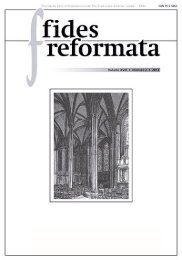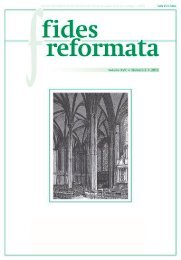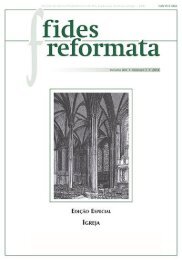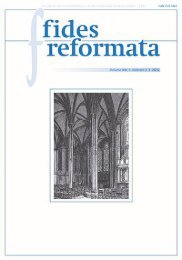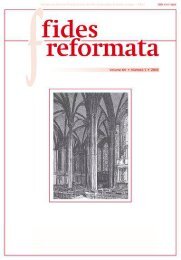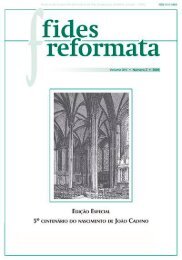You also want an ePaper? Increase the reach of your titles
YUMPU automatically turns print PDFs into web optimized ePapers that Google loves.
Breno Mace<strong>do</strong>, Covenant Theology in the Thought of John Calvin<br />
However, being a natural descendent from Abraham did not guarantee<br />
one’s participation in the promise of covenant. Calvin affirms that “…not all<br />
who are from Abraham are to be esteemed legitimate children; because they<br />
are not the children of the promise, but only of the flesh.” 58 Calvin, therefore,<br />
creates a dichotomy between promise and covenant in such a way that one<br />
may be participant of the covenant but not of its promises. To participate in the<br />
covenant alone is to be recipient only of its words, but to be participant of<br />
the promises is to share the inner effects of the covenant.<br />
For there, the promise is not taken generally for the outward word, by which<br />
God conferred his favor as well upon the reprobate as upon the elect; but must<br />
be restricted to that efficacious calling, which he inwardly seals by his Spirit. 59<br />
This dichotomy between participation in the covenant and participation<br />
in the promises provides the setting for Calvin to elaborate a concept of<br />
election in the Abrahamic covenant. He speaks of a “twofold class of sons”<br />
present in the Church. The first refers to the whole group of people who are<br />
identified as the Church. They are publicly recognized as members of the<br />
covenant and are accounted as children of God. The second class refers to<br />
those whom “the promise of the covenant is ratified by faith.” This dichotomy<br />
Calvin attributes to the “fountain of gratuitous election, whence also<br />
faith itself springs.” 60 Hoekema’s explanation of this dichotomy in Calvin<br />
is most enlightening:<br />
You could say that covenant membership is here pictured as a circle wider<br />
than particular election, but narrower than mankind as a whole. Covenant<br />
membership thus by no means guarantees one’s salvation; one like Esau<br />
and Saul may be lost despite one’s covenant membership…The covenant of<br />
grace, therefore, is here pictured, not as identical with particular election, but<br />
as a visible image of it…Calvin distinguished between two types of election:<br />
election in the wider sense, illustrated in the choice of Abraham’s seed to be<br />
his people, and therefore equivalent to the a<strong>do</strong>ption of individuals into his<br />
covenant of grace; and election in the narrower sense, which means predestination<br />
to eternal life. 61<br />
One last aspect of the Abrahamic covenant present in Calvin’s writings<br />
deserves attention: the sacrament of circumcision and its meaning. Calvin<br />
affirms circumcision to be the inscription of the covenant in Abraham’s<br />
58 Ibid., 1:448-449.<br />
59 Ibid., 1:449.<br />
60 Ibid., 1:449.<br />
61 Hoekema, “Calvin’s Doctrine of the Covenant of Grace,” 7.<br />
102






